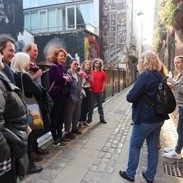Fire safety (general)
Jake Eastham

Disclaimer
Disclaimer: While every effort has been made to ensure the accuracy of the information contained in the Pink Book, we regret that we cannot be responsible for any errors. The Pink Book contains general information about laws applicable to your business. The information is not advice and should not be treated as such. Read our full disclaimer.
Key facts
Fire safety legislation applies to virtually all businesses including attractions, hotels, bed and breakfast accommodation and self-catering properties.
A ‘suitable and sufficient’ fire risk assessment must be carried out – and where there are five or more employees, the assessment should be recorded.
There should be one person responsible for the fire risk assessment and ensuring that fire protection and prevention measures are observed and maintained.
An emergency plan should be drawn up. It should be displayed in the form of a fire action notice in guest rooms and adjacent to the fire alarm call points in the staff and common areas.
Fire risk assessment template
It is a legal requirement to carry out a Fire Risk Assessment, regardless of your business size.
Smaller accommodation businesses can carry out their fire risk assessment with a downloadable template on the VisitEngland Business Advice Hub.
You can also download the Gov.uk supplementary guidance on considering the means of escape for disabled people.
Fire safety
The Regulatory Reform (Fire Safety) Order 2005 requires the ‘responsible person’ in virtually all workplaces – including attractions, hotels, bed and breakfast accommodation and self-catering properties – to adopt a self-assessment approach to fire safety in the workplace.
The Regulatory Reform (Fire Safety) Order 2005 applies to England and Wales, but there is equivalent legislation in Scotland and Northern Ireland.
- In Scotland, the Fire (Scotland) Act 2005 and the Fire Safety (Scotland) Regulations 2006 apply.
- In Northern Ireland, the relevant legislation is the Fire and Rescue Services (Northern Ireland) Order 2006.
Do the regulations apply to me?
Yes: the regulations apply to all attractions and accommodation premises, including self-catering accommodation.
Houses in multiple occupation
Properties defined as Houses in Multiple Occupation (HMOs) are subject to the Regulatory Reform (Fire Safety) Order 2005, in that the common areas that may be visited by the landlord or others are subject to a suitable and sufficient Fire Risk Assessment. The individual residential areas are not subject to this requirement. HMOs are still subject to the fire safety requirements imposed by the Housing Act 2004 .
How do I comply?
The Regulatory Reform (Fire Safety) Order 2005 requires every business to nominate a person to take responsibility for carrying out a Fire Risk Assessment of the premises, and ensure that fire protection and prevention measures are observed and maintained.
Although not a legal requirement, it is advisable to identify the nominated responsible person on the assessment document and make that person known to all staff.
New Home Office guidance states that, from 1 October 2023 all Fire Risk Assessments must be recorded. This is a change to previous requirements where Fire Risk Assessments only needed to be recorded if the business had five or more employees.
Note: it is a requirement of VisitEngland’s National Quality Assessment Scheme for accommodation that you demonstrate to the assessor that you have carried out your Fire Risk Assessment. In addition, for any business your public liability insurance provider will also require proof that you have undertaken an assessment
New fire safety guidance for small accommodation businesses
In spring 2023 the Home Office produced revised fire safety guidance for small accommodation businesses that sleep up to 10 people and where the accommodation is no higher than the first floor of the building. This guidance A Guide To Making Your Small Paying-Guest-Accommodation Safe From Fire, replaces the older Do You Have Paying Guests? guidance that was produced in 2008. The new guidance is similar to the old guidance in many ways but provides much more detail on how to undertake a fire risk assessment and contains a large number of recommendations on the steps you should take to ensure that you have fulfilled your responsibilities under the Fire Safety Order 2005. It is due to be updated again shortly in line with the new requirements from 1 October 2023. In the interim, you can check your new fire safety responsibilities from 1 October on the Gov.uk website.
The most important changes in the new guidance are:
- Recording Fire Risk Assessments
The most important change in the new guidance is that you MUST record your Fire Risk Assessment. Previously you only had to record the assessment if you had five or more staff. VisitEngland has always recommended that you record your Fire Risk Assessment in order to prove that you have fulfilled your legal responsibilities but doing this is now mandatory.
- Undertaking electrical inspections
Previous guidance recommended checking electrical equipment but did not mention the electrical system in your premises. The new guidance states that your electrical system (i.e., the distribution board and wiring of the property) should be subject to inspection and tested at least once every five years. In addition, for self-catering properties, all appliances should be visually checked between lettings and in B&Bs there should be periodic in-house service and testing in accordance with the IET Code of Practice for In-Service Inspection and Testing of Electrical Equipment.
- Heating system inspections
The new guidance states that heating and hot water systems should be inspected annually by a qualified contractor to ensure they are maintained in good condition. Previously, this requirement applied to just gas systems (your annual Gas Safe inspection), but it is now extended to all heating and hot water systems.
- Carbon Monoxide detectors
Any property with a gas appliance, fire or wood burner should have a carbon monoxide detector installed. This requirement was missing from the previous guidance.
- Sweeping chimneys and flues
Any property with a chimney or flue needs to have it swept at least annually. Again, this was missing from the previous guidance.
- Candles
The new guidance states that operators should not provide candles, tea lights or ethanol burners for use by guests, and there should be a policy in place prohibiting their use. This is important as many operators use candles as decorative features or supply tealights/tealight holders.
- Inner rooms
Inner rooms (which are rooms where the only escape route is through another room) should not be used for sleeping accommodation unless the rooms are on the ground floor and the rooms have direct access to a door or “escape window” that can be used by the occupants to reach a place of safety clear of the accommodation. Escape windows for rooms on the first floor are not considered a safe means of escape for paying guests.
This will impact many older buildings and cottages where an upstairs bedroom is accessed via another bedroom and operators are advised to contact a fire safety expert to determine what should be done to ensure the safety of people using an inner room.
To help you, the new guidance includes four examples of different accommodation types which demonstrate where fire detectors/alarms should be located. While it is not a legal requirement to follow the recommendations in the guidance, it is important to note that the Fire Safety Order states that, in any legal proceedings, a failure to comply with guidance may be relied on as tending to establish that you contravened the legislation.
Fire safety guidance for larger properties
If you have a property that accommodates more than 10 people, or your premises have sleeping accommodation above the first floor, then this guidance does not apply. Instead, the relevant guidance is Fire Safety Risk Assessment: Sleeping Accommodation.
What is a Fire Risk Assessment?
A Fire Risk Assessment is a structured consideration of the fire hazards and management of fire in the premises. It can be undertaken in five steps:
- Identify the fire hazards
- Identify the people at risk
- Evaluate, remove, reduce and protect from risk
- Record, plan, inform, instruct and train
- Review the assessment periodically
Remember: you know your premises best, so follow the guidance and assess how your staff and guests would escape from the building quickly if a fire started (under 2.5 minutes is the target time). Think about how they would be alerted, and how easily they would find their way out. After all, guest safety is the most important thing to consider – and yours too.
Identify the fire hazards
- Potential sources of ignition, for example:
- Cooking equipment
- Lighting
- Electrical apparatus
- Machinery
- Display screen equipment, for example computer screens
- Combustible materials that may burn, for example:
- The furnishings and furniture
- Parts of the building such as panelling and curtains
- Combustible linings on escape routes
- Displays
- Flammable liquids and gases, for example:
- Products used for cleaning or maintenance purposes, including those used to clean swimming pools and hot tubs;
- Fuel storage areas.
Identify the people at risk
The people at risk include:
- Customers;
- Staff;
- Contractors;
- Other visitors;
- People outside the property, for example neighbours and passers-by.
Particular note should be made of the number of people likely to be on the premises, where they could be on the premises if a fire occurs, and any persons – staff or customers – who may require additional assistance in the event of an evacuation, for example disabled people.
Evaluate, remove, reduce and protect from risk
This step involves evaluating the hazards and taking measures to eliminate these where possible. For example, the prohibition of smoking on the premises, replacing candles on tables with an alternative without an open flame, and the regular removal of rubbish from bins and storage areas will help to reduce the hazards.
Particular care should be taken when selecting curtains and display materials – especially temporary decorations used for specific events or to celebrate public holidays and festivals.
Any simple changes should be made straight away, such as clearing obstacles and removing flammable items from escape routes. If you identify something that would be too expensive or cause too much disruption to rectify straight away, make a note of the work and when you intend to carry it out. Out of season is always a good time to catch up on such work.
Record, plan, inform and train
Where there are five or more staff members, the Fire Risk Assessment must be recorded. In other cases (for example small attractions, bed and breakfast accommodation and self-catering properties) it is good practice to record the assessment anyway to demonstrate compliance with the law. The log book should contain details of maintenance and servicing to fire protection measures. It should also include details about alarms, detectors and fire extinguishers.
Note: The Government is currently considering introducing a requirement that all accommodation businesses must have a written fire risk assessment, regardless of the number of employees on the premises.
An emergency plan should be drawn up to indicate the actions that should be taken by staff, as well as customers and others, in case of a fire on the premises. This is particularly important for attractions where the customers are in enclosed spaces and/or in large groups (for example escape rooms and theatres).
The plan, in the form of a Fire Action Notice, should be displayed adjacent to the fire alarm call points in the staff and public areas. For accommodation businesses, it should also be displayed in guest bedrooms.
These actions should include the measures that would be taken to identify and assist disabled people to leave the premises safely.
Staff should be trained in the actions that they would be expected to take in an emergency, and this should include all staff participating in periodic fire drills at least once – and preferably twice – a year. Where staff do not speak fluent English, special attention should be given to ensuring that instructions are fully understood.
Where an attraction or hotel is part of a complex of buildings (such as a shopping centre) or parts of the buildings are occupied by franchise holders, then the responsible person should liaise with the appropriate staff in these areas.
Review the assessment periodically
The Fire Risk Assessment for the premises should be reviewed periodically and when:
Alterations are made to the structure or layout of the premises.
There are changes in the use of an area of the building.
There are significant changes to the number or location of the visitors or staff.
There is a significant change in the mobility level or other factors influencing the response of visitors or staff in an emergency.
There are changes in the management of the building.
There are no prescribed times for the reviews, but many businesses choose to review their assessment annually.
How do I know which fire precautions I need?
It is up to the nominated person to determine the appropriate fire precautions as a result of their Fire Risk Assessment.
For accommodation businesses, the guidance publication Do You Have Paying Guests? is provided by the Government. It gives advice tailored specifically to bed and breakfast, guesthouses and self-catering properties. It is designed to encourage compliance by giving businesses practical advice on reducing fire risks in their establishments. It explains the risk assessment process, sets out sources of further advice and guidance, and offers some practical information for owners on what may represent appropriate and proportionate fire safety measures in these types of premises.
For attractions, the Home Office produces two publications: Fire safety risk assessment: small and medium places of assembly, which is targeted at places that accommodate up to 60 people (small) and up to 300 people (medium), and Fire safety risk assessment: large places of assembly, for premises that hold over 300 people.
There is also separate guidance for:
Outdoor attractions and events: Fire safety risk assessment: open-air events and venues.
Theatres and music halls: Fire safety risk assessment: theatres, cinemas and similar premises.
Zoos and farm parks: Fire safety risk assessment: animal premises and stables.
These guidance documents contain detailed information on how to undertake a Fire Risk Assessment related to different business types, as well as templates for the assessment and fire safety maintenance checklists. There are also sections in the guidance documents on how to adapt fire precautions for historic buildings.
The most important factor is fire prevention. Staff should be made aware of fire hazards and safe working practices in order to prevent a fire breaking out. There should be an emergency plan drawn up so that all staff know what actions they should take in the event of a fire.
The fire protection provisions will vary according to the particular premises, but should include the following:
Means of escape: in all premises it is important that there are adequate means of escape. In all but the smallest guesthouses there should normally be at least two escape routes from all parts of the building, and these should be available for use and free of obstructions at all times.
Fire alarm: there should be a means of alerting people to a fire, should it break out. See below for more details.
Emergency lighting: in order for everyone to find their way out of the building safely there should be automatic emergency escape lighting. In some very small guesthouses there may be sufficient ‘borrowed light’ from street lights outside, but this is not often the case.
Signs: these should be prominently displayed to guide guests to the fire exits with which they will not be familiar.
Firefighting equipment: a suitable number of appropriate fire extinguishers should be provided, and at least some staff should be instructed in their use.
Which alarm system?
Since the interpretation may vary with each fire service around the country, it is difficult to guide businesses in a general way on exactly what type of alarm system they should fit.
The types of system required will, however, depend on the level of the risk: a very sophisticated system would not be necessary in small premises. Whichever system is used should account for disabled people (for example those with hearing loss), so that their safety is not compromised.
The Regulatory Reform (Fire Safety) Order 2005 requires that premises are provided with suitable and sufficient means of detecting fire and giving warning in the event of a fire. For small buildings this may be linked to mains-powered smoke and heat alarms that both sound in the event of fire.
Guidelines for small premises are that they can install simple systems – LD2 or LD3 – that comprise mains-operated smoke and heat alarms with battery back-up. Current legislation defines a ‘small’ property as being up to two storeys high (from the ground) with no floor more than 200 sq m in total. This equates to a floor with eight to 10 en-suite double rooms.
LD2 properties must have alarms in corridors and all rooms leading off the main escape route, while LD3 properties require them only in the corridor, landing and hallway of the main escape route. These LD3 alarms are the same as those required in all new homes. If the property was built after 1990, it is likely to comply already.
Larger properties may be expected to install more sophisticated detectors and alarms, which are classed as L2 systems.
Note: the Home Office will shortly publish the guidance publication Do You Have Paying Guests?, which will contain more detailed information on the types of fire safety measures that would be appropriate in different accommodation types.
How do I undertake the assessment?
Guidance on undertaking a Fire Risk Assessment is set out on the fire safety in the workplace pages on the Gov.uk website. Further advice can be gained from a fire safety consultant or your local fire authority.
Fire risk assessment template for small accommodation businesses
VisitEngland provides a free downloadable Fire Risk Assessment template for smaller domestic-type accommodation.
How do I record the Fire Risk Assessment?
The legislation does not prescribe a specific format for the assessment, but you do need to record the significant findings and the persons especially at risk from fire. The significant findings are a list of the actions that should be taken to reduce the fire hazards to a minimum.
You should also record any shortcomings that are identified in the management of the general fire precautions. A note should be kept of the remedial actions that are taken to demonstrate to the fire brigade, should they visit, that you are taking steps to address these matters.
Is the assessment a one-off exercise?
No, you are required to keep your assessment under review and update it when necessary. A new assessment should always be undertaken whenever a property is renovated or structurally altered.
Who enforces the legislation?
The Regulatory Reform (Fire Safety) Order 2005 is enforced by the local fire and rescue service. Fire Safety Officers will make periodic visits to the premises and will ask to see the fire risk assessment to ensure that it is ‘suitable and sufficient’.
What do Fire Safety Officers look at?
As well as inspecting the means of escape and other fire precautions, the Fire Safety Officer may ask to see the fire log book containing the records of the servicing and maintenance of the fire protection measures (for example, the automatic fire detection and alarm system and the emergency lighting).
The officer may also ask to see the record of false fire alarms in the premises, so these should also be kept up-to-date.
Notices
If your property does not meet the requirements, the Fire Safety Officer will provide practical advice or, if the risk is serious or if the officer is not satisfied, you may be issued with one of the following:
An alterations notice: this does not require alterations to be made to the premises. It is served when the enforcing authority believes that there will be a serious risk to people in the building if a change is made to any particular part of the premises or their use.
An enforcement notice: this requires certain measures to be taken within a specified timeframe.
A prohibition notice: this requires the business to cease trading immediately until certain remedial action has been taken.
In all cases, you will have a right of appeal, both informally and formally. An informal appeal can sometimes identify a different way of meeting the Order which satisfies both parties.
The fire authority will work with you to achieve a satisfactory level of fire safety.
Further guidance
Fire safety for accommodation businesses
You can download Do you have Paying Guests? a guide designed to provide advice on fire safety to small accommodation businesses, from Gov.uk.
Making your premises safe from fire
You can download Regulatory Reform (Fire Safety) Order 2005 - A short guide to making your premises safe from fire from Gov.uk.
Fire evacuation for disabled guests
You can download Fire Safety Risk Assessment - Means of Escape for Disabled People from Gov.uk.
Fire risk assessments: accommodation
You can download Fire Risk Assessment for sleeping accommodation from Gov.uk.
Fire risk assessments: attractions (general)
You can download the general guidance in Fire Safety in the Workplace from Gov.uk.
Fire risk assessment for small attractions
You can download Fire safety risk assessment: small and medium places of assembly from Gov.uk.
Fire risk assessment for large attractions
You can download Fire safety risk assessment: large places of assembly from Gov.uk.
Fire risk assessment for outdoor attractions
You can download Fire safety risk assessment: open-air events and venues from Gov.uk.
Fire risk assessment for theatres/music halls
You can download Fire safety risk assessment: theatres, cinemas and similar premises from Gov.uk.
Fire risk assessment for zoos and farm parks
You can download Fire safety risk assessment: animal premises and stables from Gov.uk.
The Purple Guide
Guidance from the Events Industry Forum for businesses staging events on their premises, from safety to waste disposal, can be found in The Purple Guide.







